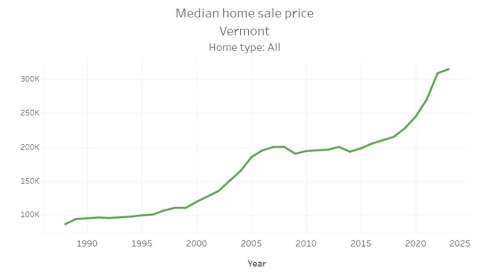The median sales price of primary homes sold in Vermont continued increasing in the first half of 2023, reaching a median value of $315,000 for homes sold during that period, according to recent Vermont Property Transfer Tax (PTT) records. This continues a trend in which no county in Vermont has seen a decline in annual median home sale price during the period from 2019-2022.

This occurred while the median length of time on the market of for-sale homes continued a multi-year trend as it fell further to 56 days, according to statewide listings in the Multiple Listing Service (MLS) in June 2023. These metrics, along with other indicators describing current and historic housing market conditions, are now available through June of 2023 for every Vermont community (town and county) on VHFA’s housingdata.org.
What is Property Transfer Tax (PTT) Data?
Vermont’s PTT is a tax collected by the Vermont Department of Taxes when property ownership is transferred between parties. This dataset is a reliable indicator of current market conditions as parties involved in all residential properties sales in the state must comply with this tax to confirm the title transfer and to be considered the valid owner of the property.
All title transfers, whether from sale or through the estate transfer process, are recorded through this means and are available through the state Department of Taxes website. Our Community Relations & Research team at VHFA collects, analyzes, and clarifies what the complex PTT data set might mean for our housing market, ultimately presenting it free-to-the-public on housingdata.org.
Recent Home Price Trends
The median Vermont home sold for $315,000 during the first six months of 2023. Compared to a $309,000 median sale price for 2022, median sale prices increased 1.9% during the first half of the calendar year. This figure represents single-unit homes only used as primary residences and includes: single-family detached homes, condominiums, and manufactured/mobile homes sold with land. Multi-unit buildings, undeveloped land, and manufactured homes without land are not included in the median price.
No county in Vermont has seen a decline in annual median home sale price since prior to 2019. Most counties in the state have experienced price fluctuation since 2000, with some even experiencing significant periods of decreasing median sale prices, especially prior to 2014. Since the outset of the Covid-19 pandemic, this pattern has changed. Home prices increased consistently throughout the state in all counties starting in 2019 and persisting through 2022.
Chittenden County continues to have the highest home prices in the state and the most consistent level of annual home price increase, with the median primary home selling for $450,000 after increasing 3.5% during 2022. Chittenden County has seen price growth in every year this century, except 2009 and 2011 amidst the fallout of the Great Recession. Prior to the pandemic, the largest annual home sale price increases occurred in and around the Burlington metro area, which serves as the state’s largest job center.
Should this trend continue statewide, the annual percentage increase in home prices may vary on a year-to-year basis, but overall, median home prices will likely continue to increase in most areas of the state in each coming year. First half of 2023 numbers indicating slight declines in median sale value indicate that this trend may be changing in some areas of the state, but more data is needed to determine if this is the case.
These trends do not yet include the impacts of the historic Flood of 2023 experienced in much of the state and destroyed many homes. This may impact future home sale prices in Vermont’s hardest hit communities.
Notably, during the first six months of 2023, the median manufactured home sold for $130,000, significantly lower than their “stick-built”/site-built counterparts. That sale value includes the factory-built home and the land it is sited on. Manufactured homes sold without land (in a land-lease community sometimes referred to as a “mobile home park”) had a median sale price of $49,498 in 2022.
The lower sale price of manufactured homes, however, does not substantially impact statewide median home sale price figures because far fewer manufactured homes (274 homes) were sold compared to site-built homes (7514 homes sold in 2022). While lesser in number, the lower median sale price is significant and worth noting in the context of the broader conversations about affordable housing and environmental justice taking place currently in Vermont.
Potential Reasons for Changes in Median Home Sale Price
Historically, certain aspects of the home sale market follow a seasonal cycle in Vermont. Most sales take place in the warmer spring and summer months. This is also when we see the greatest increase in home sale prices. In the winter, fewer homes are sold, as it is simply more challenging and less desirable to sell a home during harsh weather. This is born out in the data as days on market consistently increases during winter months.
The median length of time a Vermont home is on the market has continuously decreased every year since 2012. During 2022, the median home was sold in 64 days. In 2016, homes were on the market for twice as long, with a median of 137 days. This suggests that presently, the state continues to experience strong demand among homebuyers relative to the inventory of homes for sale. Length of time on market is also seasonally dependent. Despite an overall downward trend, the length on market was 58 days in June 2022, but back up to 82 days in February 2023.
Despite the increase in home prices, the number of homes sold in Vermont has not been impacted. In fact, median home prices have increased, and more homes were sold statewide every year since 2017. This is an indicator that consistent demand has driven up home prices in Vermont, with the trend emerging even before the outset of the pandemic. However, it should be noted that while the overall volume of home sales was still high, fewer homes were sold in 2022 (7,764 homes) than in 2021 (8,408 homes). Even though this is a decrease, more homes were sold in 2021 than all other years between 2006-2019.
Additional Data on Vermont’s Home Sales
Using a combination of other data sources beyond PTT, housingdata.org site visitors can also view data exclusively for newly constructed homes. The median price of new homes has increased dramatically in the state since 2019, increasing from $365,569 up to $555,264 in 2022. This represents a 52% increase in the cost of a new home in just three years.
https://housingdata.org/profile/homeownership-costs/new-home-sales
The dramatically increased cost of new housing is particularly notable in Vermont, as the state’s housing stock is amongst the oldest in the country. Nearly 26% of the homes in the state were built prior to 1939; more than 58% of the homes were built prior to 1980. While the age of a home is not a direct indicator of its quality, older homes require regular upkeep and are, in general, more likely to become unsafe for habitation. This highlights the need for continued maintenance and improvement of Vermont’s housing stock to prevent older homes from exiting the tight housing stock due to maintenance deferral.
Vermont Housing Finance Agency (VHFA) programs are available to help moderate-income Vermonters become homeowners. In addition to its affordable mortgage and down payment assistance programs, VHFA also launched the Missing Middle Income Homeownership Development Program to provide subsidies and incentives for homebuilders to construct or rehabilitate modest homes affordable to homebuyers at 120% area median income or lower. For more information and data analysis about current housing market conditions, explore more of the visualizations available on housingdata.org.

